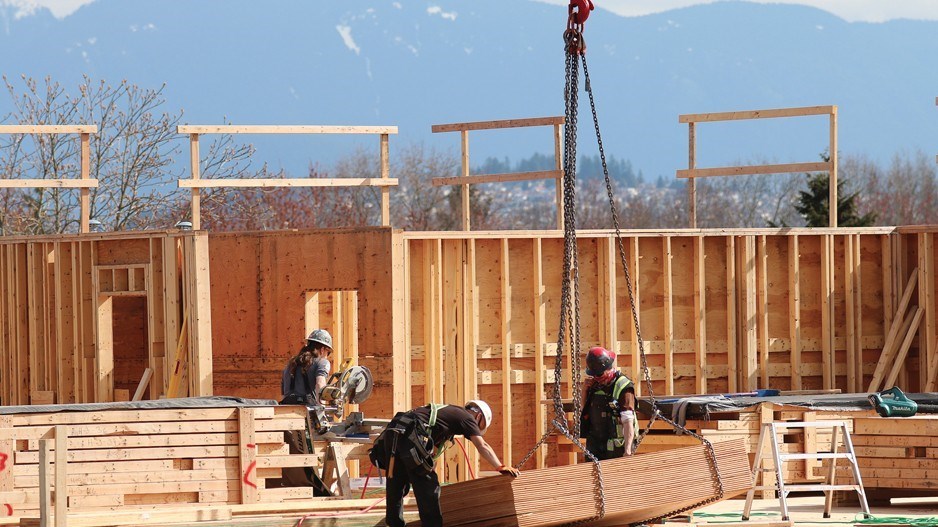The provincial government’s goal to reduce greenhouse gas emissions may be competing with one of the province’s top priorities—the construction of more affordable housing.
Efforts to make B.C.’s built environment greener come with costs, and regulations that support reduced emissions are being implemented at a time when the development industry is navigating a slew of new legislation, said developer Jason Turcotte.
“Is that the priority, eliminating altogether the use of fossil fuels if we know, and we know without a doubt, it makes building housing more expensive?” said Turcotte, president of Darwin Properties Ltd.
“You can see these competing objectives and how they don’t align at all.”
By 2032, the province’s CleanBC plan aims to ensure that all new buildings in the province will be “net-zero energy ready.”
This means that buildings are to be so efficient that they meet “all or most of their own energy consumption requirements with onsite renewable energy technologies,” according to the plan.
The province plans to achieve this through the BC Building Code and Zero Carbon Step Code. The latter is a provincial standard that communities can choose to adopt.
The Zero Carbon Step Code features different steps to reduce emissions from space-heating and water-heating systems. Higher steps require greater reductions of carbon emissions.
The code also sets greenhouse gas emissions targets for new buildings, and is intended to complement the BC Energy Step Code, which sets energy efficiency requirements for new buildings.
The Zero Carbon Step Code came into effect on May 1, 2023 as part of BC Building Code changes. It requires 20 per cent better energy efficiency for most new buildings throughout the province.
As of March of this year, there are at least 22 local governments that have already implemented the Zero Carbon Step Code, the B.C. Ministry of Housing said in a statement to BIV.
When asked what progress has been made on making all new buildings “net-zero energy ready” by 2032, the Ministry of Housing said the province does not currently track data on this specific target.
However, it is estimated that 44 per cent of all new residential units in large multi-family buildings and 30 per cent of new units in small residential buildings will be built in municipalities that had adopted this code or equivalent regulations as of January 2024, said the ministry.
“We need our buildings to be resilient. We know we’re seeing more and more heat domes, forest fires, flooding and these sorts of things. … We have to build more houses and let’s build them so that they’re climate future-ready,” said Chris Hill, founder of BCollective Homes Inc. and a member of the Urban Land Institute’s (ULI) Net-Zero Commission.
Canada’s existing buildings release roughly 90 million tonnes of greenhouse gases annually, according to a May 2023 report by George Brown College’s Brookfield Sustainability Institute and the RBC Climate Action Institute.
The report says that if Canada builds 5.8 million new homes by 2030 to meet growing housing demand, this will add up to 18 million tonnes of greenhouse gas emissions annually to the country’s carbon footprint if current practices and building codes are used.
While Hill is a proponent of the effort to make buildings more “resilient,” he said that there needs to be more consistency across the Metro Vancouver region.
“Right now, we’re building a number of projects that are on various different steps,” he said, referring to the different levels of the step code.
“What is the hardest thing on the ground is going to job sites with different sets of rules.”
The development industry is working to grapple with new legislation around transit-oriented development, multiple units on single-family lots and updates to the BC Building Code that came into effect on March 8 and require increased seismic safety measures and accessibility, said Turcotte.
“Slow it down. All these changes add cost, which means we need bigger revenue to justify the risk to take on the project to make it viable,” he said.
“I feel like half of my time now is staying current with the onslaught of new government legislation, regulation, code changes and fee changes. Forget actually doing any work.”
Turcotte said that one solution could be to focus new regulations on certain types of buildings.
“We need to build condominiums and multi-family, which are inherently more efficient,” he said.
“Let’s shift away from trying to make something that’s already efficient more and more efficient, and focus on the real problem children, if you will. The heavy industries and the single-family homes, etc. That’s a way to start to satisfy both objectives without compromising one or the other.”
When it comes to cost, Hill said that utilizing off-site prefabricated construction or net-zero level products are starting to come into a price range that is comparable to conventional building techniques.
“When we’re in control of the project, have experienced people that have built green projects and you’re not dealing with a learning curve, the costs are fairly insignificant,” said Hill.
“We’ve gone through that learning curve and so 100 per cent, somebody doing something different for the first time is going to cost more.”







